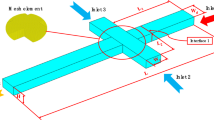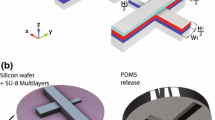Abstract
Flow focusing generators have been widely used to generate droplets for many applications which call for accurate physical models that describe the droplet formation process in such configurations for design and operation purposes. Most existing models are empirical correlations obtained based on extensive experimental results and thus very sensitive to their own data sets. A comprehensive model that involves less parameter fitting by incorporating more theoretical arguments and thus has an improved applicability is urgently needed to guide the design and operation of flow focusing generators. This work presents a 3D physical model describing the droplet formation process in microfluidic flow focusing generators that operate in the squeezing regime where droplet size is usually larger than the channel width. This model incorporates an accurate geometric description of the 3D droplet shape during the formation process, an estimation of the time period for the formation cycle based on the conservation of mass and a semi-analytical model predicting the pressure drop over the 3D corner gutter between the droplet curvature and channel walls, which allow an accurate determination of the droplet size, spacing and formation frequency. The model considers the influences of channel geometry (height-to-width ratio), viscosity contrast, flow rate ratio and capillary number with a wide variety. This model is validated by comparing predictions from the model with experimental results obtained through high-speed imaging.










Similar content being viewed by others
Abbreviations
- 2D:
-
Two-dimensional
- 3D:
-
Three-dimensional
- A :
-
Area
- Ca :
-
Capillary number
- D h :
-
Hydraulic diameter
- F :
-
Frame rate
- f :
-
Droplet generation frequency
- h :
-
Channel height
- L eqv :
-
Equivalent droplet length of the uniform cross section
- L fill :
-
Droplet length that penetrates into the main channel at the end of the filling stage
- \(L_{\text{gutter}}^{ }\) :
-
Length of the gutter at the end of the necking stage
- \(L_{\text{pinch}}\) :
-
Distance between the two points of the V-shape at the end of the necking stage
- \(\Delta L_{\text{pinch}}^{ }\) :
-
Variation of the V-shape in the droplet length direction during the necking stage
- \(N_{\text{drop}}\) :
-
Number of the captured droplets in one video
- \(N_{\text{frame}}\) :
-
Total number of frames in one video
- P 1 :
-
Pressure of the forming droplet at the end of the filling stage
- P 2 :
-
Pressure of the continuous phase at the cross at the end of the filling stage
- P 3 :
-
Pressure of the continuous phase surrounding the tip of forming droplet at the end of the filling stage
- \(\Delta P_{{ 3 {\text{D}}}}\) :
-
Pressure drop from the 3D numerical simulations
- \(\Delta P_{\text{asy}}\) :
-
Pressure drop from the asymptotic model
- \(P_{\text{neck}}\) :
-
Pressure of the continuous phase at the cross at the end of necking stage
- \(P_{\text{tip}}\) :
-
Pressure of the continuous phase surrounding the tip of forming droplet at the end of the necking stage
- Q :
-
Flow rate
- \(\bar{Q}_{\text{gutter}}\) :
-
Average flow rate through the gutter during the necking stage
- \(R_{\text{neck}}\) :
-
Radius of the V-shape neck at the end of the necking stage
- s :
-
Spacing between two droplets
- T :
-
Droplet generation period
- \(\Delta t_{\text{filling}}\) :
-
Filling period
- \(\Delta t_{\text{necking}}\) :
-
Necking period
- u :
-
Fluid velocity
- \(\bar{u}_{g}\) :
-
Average fluid velocity in the gutter
- V BF :
-
Volume of droplet at the beginning of the filling stage
- V BN :
-
Volume of the continuous phase in the V-shape at the beginning of the necking stage
- V d :
-
Droplet volume
- V EF :
-
Volume of droplet at the end of the filling stage
- V EN :
-
Volume of the continuous phase in the V-shape at the end of the necking stage
- V gutter :
-
Volume of the continuous phase bypassing the gutter during the necking stage
- \(v_{\text{l}}^{ }\) :
-
The slope \(\Delta L_{\text{pinch}}^{ } /\Delta t\)
- \(v_{\text{w}}^{ }\) :
-
The slope \(\Delta W_{\text{pinch}}^{ } /\Delta t\)
- W fill :
-
Width of the tip at the end of the filling stage
- W pinch :
-
Width of the neck at the end of the necking stage
- \(\Delta W_{\text{pinch}}^{ }\) :
-
Variation of the V-shape in the droplet width direction during the necking stage
- w :
-
Channel width
- α :
-
Defined as \(V_{\text{EF}}^{ *} - V_{\text{BF}}^{ *}\)
- β :
-
Defined as \(V_{\text{EN}}^{ *} - V_{\text{BN}}^{ *} + V_{\text{gutter}}^{ *}\)
- φ :
-
Dispersed phase to continuous phase flow rate ratio
- γ :
-
Interfacial tension
- η :
-
Dispersed phase to continuous phase viscosity ratio
- μ :
-
Fluid viscosity
- c:
-
Continuous phase
- d:
-
Dispersed phase
- *:
-
Dimensionless form of variables
References
Anna SL, Mayer HC (2006) Microscale tipstreaming in a microfluidic flow focusing device. Phys Fluids 18:121512
Anna SL, Bontoux N, Stone HA (2003) Formation of dispersions using ‘flow focusing’ in microchannels. Appl Phys Lett 82:364–366
Bardin D, Martz TD, Sheeran PS, Shih R, Dayton PA, Lee AP (2011) High-speed, clinical-scale microfluidic generation of stable phase-change droplets for gas embolotherapy. Lab Chip 11:3990–3998
Christopher GF, Anna SL (2007) Microfluidic methods for generating continuous droplet streams. J Phys D Appl Phys 40:319–336
Cubaud T, Mason TG (2008) Capillary threads and viscous droplets in square microchannels. Phys Fluids 20:053302
De Menech M, Garstecki P, Jousse F, Stone HA (2008) Transition from squeezing to dripping in a microfluidic T-shaped junction. J Fluid Mech 595:141–161
Dupin M, Halliday I, Care C (2006) Simulation of a microfluidic flow-focusing device. Phys Rev E 73:055701
Garstecki P, Gitlin I, DiLuzio W, Whitesides GM, Kumacheva E, Stone HA (2004) Formation of monodisperse bubbles in a microfluidic flow-focusing device. Appl Phys Lett 85:2649–2651
Garstecki P, Stone HA, Whitesides GM (2005) Mechanism for flow-rate controlled breakup in confined geometries: a route to monodisperse emulsions. Phys Rev Lett 94:164501
Garstecki P, Fuerstman MJ, Stone HA, Whitesides GM (2006) Formation of droplets and bubbles in a microfluidic T-junction-scaling and mechanism of break-up. Lab Chip 6:437–446
Glawdel T, Ren C (2012) Global network design for robust operation of microfluidic droplet generators with pressure-driven flow. Microfluid Nanofluidics 13:469–480
Glawdel T, Elbuken C, Ren C (2012a) Droplet formation in microfluidic T-junction generators operating in the transitional regime. I. Experimental observations. Phys Rev E 85:016322
Glawdel T, Elbuken C, Ren C (2012b) Droplet formation in microfluidic T-junction generators operating in the transitional regime. II. Modeling. Phys Rev E 85:016323
Huebner A, Sharma S, Srisa-Art M, Hollfelder F, Edel JB, Demello AJ (2008) Microdroplets: a sea of applications? Lab Chip 8:1244–1254
Jakiela S, Makulska S, Korczyk PM, Garstecki P (2011) Speed of flow of individual droplets in microfluidic channels as a function of the capillary number, volume of droplets and contrast of viscosities. Lab Chip 11:3603–3608
Jebrail MJ, Bartsch MS, Patel KD (2012) Digital microfluidics: a versatile tool for applications in chemistry, biology and medicine. Lab Chip 12:2452–2463
Jensen MJ, Stone HA, Bruus H (2006) A numerical study of two-phase stokes flow in an axisymmetric flow-focusing device. Phys Fluids 18:077103
Lagus TP, Edd JF (2013) A review of the theory, methods and recent applications of high-throughput single-cell droplet microfluidic. J Phys D Appl Phys 46:114005
Lee W, Walker LM, Anna SL (2009) Role of geometry and fluid properties in droplet and thread formation processes in planar flow focusing. Phys Fluids 21:032103
Li W, Nie Z, Zhang H, Paquet C, Seo M, Garstecki P, Kumacheva E (2007) Screening of the effect of surface energy of microchannels on microfluidic emulsification. Langmuir 23:8010–8014
Liu H, Zhang Y (2011) Droplet formation in microfluidic cross-junctions. Phys Fluids 23:082101
Nie Z, Seo M, Xu S, Lewis PC, Mok M, Kumacheva E, Whitesides GM, Garstecki P, Stone HA (2008) Emulsification in a microfluidic flow-focusing device: effect of the viscosities of the liquids. Microfluid Nanofluidics 5:585–594
Notz PK, Chen AU, Basaran OA (2001) Satellite drops: unexpected dynamics and change of scaling during pinch-off. Phys Fluids 13:549–552
Ong WL, Hua J, Zhang B, Teo TY, Zhuo J, Nguyen NT, Ranganathan N, Yobas L (2007) Experimental and computational analysis of droplet formation in a high-performance flow-focusing geometry. Sens Actuators A 138:203–212
Park JM, Anderson PD (2012) A ternary model for double-emulsion formation in a capillary microfluidic device. Lab Chip 12:2672–2677
Romero PA, Abate AR (2012) Flow focusing geometry generates droplets through a plug and squeeze mechanism. Lab Chip 12:5130–5132
Seemann R, Brinkmann M, Pfohl T, Herminghaus S (2012) Droplet based microfluidics. Rep Prog Phys 75:016601
Tan YC, Cristini V, Lee AP (2006) Monodispersed microfluidic droplet generation by shear focusing microfluidic device. Sens Actuators B 114:350–356
Tchikanda SW, Nilson RH, Griffiths SK (2004) Modeling of pressure and shear-driven flows in open rectangular microchannels. Int J Heat Mass Transf 47:527–538
van Hoeve W, Dollet B, Versluis M, Lohse D (2011) Microbubble formation and pinch-off scaling exponent in flow-focusing devices. Phys Fluids 23:092001
van Steijn V, Kleijn CR, Kreutzer MT (2009) Flows around confined bubbles and their importance in triggering pinch-off. Phys Rev Lett 103:214501
van Steijn V, Kleijn CR, Kreutzer MT (2010) Predictive model for the size of bubbles and droplets created in microfluidic T-junctions. Lab Chip 10:2513–2518
Ward T, Faivre M, Abkarian M, Stone HA (2005) Microfluidic flow focusing drop size and scaling in pressure versus flow rate driven pumping. Electrophoresis 26:3716–3724
Wong H, Radke CJ, Morris S (1995) The motion of long bubbles in polygonal capillaries. Part 1. Thin films. J Fluid Mech 292:71–94
Acknowledgments
The authors acknowledge the Natural Science and Engineering Research Council of Canada for research grants to C. Ren, scholarships to T. Glawdel and N. Cui, and Canada Research Chair program, Canada Foundation for Innovation, and University of Waterloo for research Grants to C. Ren.
Author information
Authors and Affiliations
Corresponding author
Electronic supplementary material
Below is the link to the electronic supplementary material.
Rights and permissions
About this article
Cite this article
Chen, X., Glawdel, T., Cui, N. et al. Model of droplet generation in flow focusing generators operating in the squeezing regime. Microfluid Nanofluid 18, 1341–1353 (2015). https://doi.org/10.1007/s10404-014-1533-5
Received:
Accepted:
Published:
Issue Date:
DOI: https://doi.org/10.1007/s10404-014-1533-5




